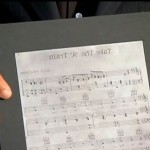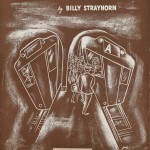Serenaded by the strains of the not-exactly-relevant-but-totally-catchy “Watching the Detectives” by Elvis Costello, I settle in to view this week’s episode of the History Detectives.
 The first segment features metal printing plates of Duke Ellington’s signature tune, “Take the ‘A’ Train.” Garfield Gillings of Brooklyn, New York, shows sociologist and History Detective Tukufu Zuberi a set of beautiful metal plates with the sheet music for the famous song engraved on them backwards.
The first segment features metal printing plates of Duke Ellington’s signature tune, “Take the ‘A’ Train.” Garfield Gillings of Brooklyn, New York, shows sociologist and History Detective Tukufu Zuberi a set of beautiful metal plates with the sheet music for the famous song engraved on them backwards.
He found them in a dumpster in Harlem 20 years ago, and wonders if they may be the original printing plates of the song. There’s no publisher name or copyright notice on them.
Zuberi’s first stop is with printing historian Frank Romano, who tells him they are indeed intaglio plates used for music typsetting between 1939 and 1944. “Take the ‘A’ Train” hit the charts in 1941, so the timing fits. Romano notes that it’s amazing the plates survived the war. They’re made out of tin and lead, metals that were getting recycled constantly for the war effort.
He also answers the question of why there’s no ownership information on the plates. Each plate was engraved by a professional, and then printed off of only once. The print was then photographed and a negative made. A small piece of film with the current copyright information would be added to the negative, and that negative would then be transferred to a high speed printing press for publishing. That way the plates could still be used even if the publishing info changed.
Next up is Loren Schoenberg, of the National Jazz Museum in Harlem. He points out that “Take the ‘A’ Train” was the first piece of music Ellington published via his own music publishing company, Tempo Music Co. He was a pioneer in this. Many African-American musicians like Miles Davis and John Coltrane followed in his footsteps and created businesses so they could keep full ownership of their music and retain the profits from its publishing.
Ironically, Billy Strayhorn, the pianist and composer who wrote “‘A’ Train”, got a salary from Ellington, but didn’t own the publishing rights to his own song. Eventually, after many years of collaboration, Duke gave him a 10% share of the company.
Jazz historian Stanley Crouch says Strayhorn may have been a victim of his own genius. He was so good at composing in Ellington’s style that people widely assumed Ellington was the author.
Now it’s on to the Smithsonian’s National Museum of American History, where Ellington collection curator John Hasse oohs and aahs a little over the plates. They have over 100,000 pages of Ellington’s unpublished music, but even he has never seen printing plates before.
He says that not only was Tempo Music Co. a pioneering endeavor from an artist to own his art, but at times it actually sustained Duke Ellington’s band. Running the ban was a high cost operation; sometimes they ended up in the red and it was the publishing arm that made enough money to keep the band on the road.
 In 1944, for example, the band made $404,969.67. Their expenses were an exhorbitant $394,711.94, leaving the entire band with a net profit of $10,257.73 for the year. The whole band was supposed to live on that! Even in 1944, that’s a lot of tap water and ramen noodles right there.
In 1944, for example, the band made $404,969.67. Their expenses were an exhorbitant $394,711.94, leaving the entire band with a net profit of $10,257.73 for the year. The whole band was supposed to live on that! Even in 1944, that’s a lot of tap water and ramen noodles right there.
Then John Hassey whips out the first print edition of “Take the ‘A’ Train”, published by Tempo Music Co. in 1941. Except for the copyright notice on the bottom of the page, it matches the plates exactly.
Tukufu Zuberi goes back to Brooklyn to share the good news with Garfield: he dumpster-dived himself up the original printing plates of one of the most famous jazz tunes in history, and the first hit of artist publishing pioneer, Tempo Music Co. Garfield is adorably excited, as well he should be.
A transcript of this segment is available in pdf format here. The full episode can be viewed online here, although fair warning, the viewer inevitable crashes my Firefox browser. It works fine in IE 8.

